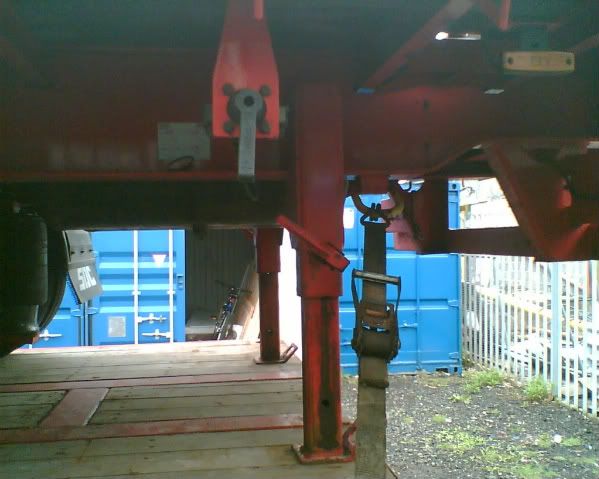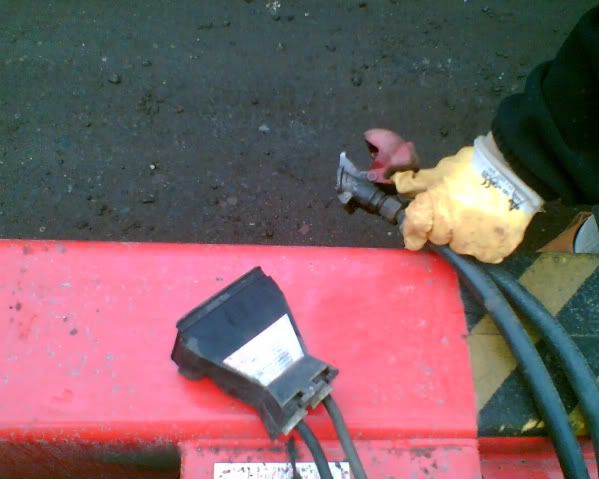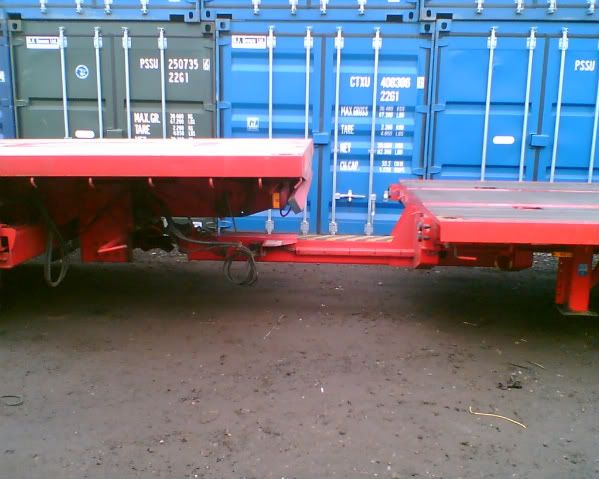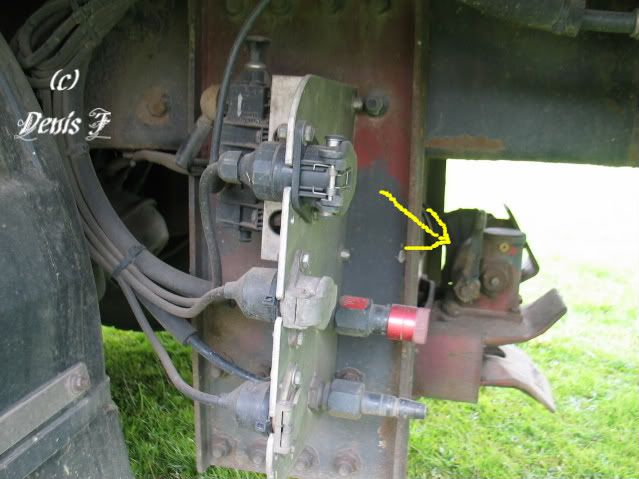Just as another thought why are we not allowed to have 10x2 or 10x4 chassis with either a steer axle behind the bogie or a mid lift in front. We are getting bin wagons with three rear axles, why could you not have a twin steer arrangemant also and a greater capacity (ie 40t same as an artic)
8wheels:
…
why could you not have a twin steer arrangemant also and a greater capacity (ie 40t same as an artic)
Could it be something to do with the axle spacing?
Zetorpilot:
Wheel Nut:
As mentioned Richard Long already runs a clever drawbar rig with a proper truck at the front. or you can go ex army equipment with a King like this.Interesting towing eye on that trailer - is that normal for the UK?
The ones here are are sleeved with something like a bearing shell pressed into the actual eye. The maximum play allowed is 2mm. I’ll try and remember to photograph mine tonight.
Like has already been said, that’s military type towing eye which is also in use in the Finnish army vehicles. Although most “ordinary” trailers in the Finnish army i.e. ones made by commercial trailer manufacturer are equipped with the more typical towing eye you described, this one is used in the trailers which are made to be towed off-road. That is, cannons, mortars, trailers with field communications equipment, etc. and in that use, when on off-road, the another type towing eye would probably be bend sooner than later. This type towing eye also requires different type coupling on truck end (actually a hook rather than coupling) and that coupling looks quite the same as is found from tractors.
8wheels:
Just as another thought why are we not allowed to have 10x2 or 10x4 chassis with either a steer axle behind the bogie or a mid lift in front. We are getting bin wagons with three rear axles, why could you not have a twin steer arrangemant also and a greater capacity (ie 40t same as an artic)
Here in Finland that type lorry (12 metres long rigid, five axles) can be rated to 38 tonnes but if my memory serves me correct those lorries have different restriction than four axle lorries regarding maximum weight per every metre between 1st and 5th axle or something like that. Maybe Zetorpilot knows the right term when I say it’s “siltasääntö” in Finnish. I think some countries in Europe even allow 50 tonnes for that configuration (Netherlands maybe?).
edit:
8wheels: One like this you mean?

siltasääntö:
logy.fi/yhdistys/sanasto.php?sanasto_lang=en
LOGY translates this literally, ie as “bridge rule” - which means nothing to me except to give the idea that this is, er, something to do with axle spacing…
As a follow on from denis’s post here’s a few pictures showing the set up I use.
The rear legs are there to prevent the trailer tipping back if you uncouple while loaded but they also useful in that ,it’s alot more stable when you piggy back the trailer.

Working with a crane vehicle means I tend to piggy back quite alot cos ,1-the truck run beter carrying rather than pulling and ,2- it’s a dam site cheaper on the island ferries,18.5 metres shortend down to 13metres makes a big difference when your charged by the metre. ![]() .
.
One thing you do need to bear in mind if you do plan to lift the trailer is that you would need some sort of additional support on the axles to prevent damage to the air bags and the load sensing valve.Proper lifting eyes on the trailer also will prevent damage to the boby caused by unsuitable slinging.

The pin that I work with is not air opperated so we fitted an extention to the lever, this prevents me having to crawl under the chassis to disengage the pin .

Wheelnut mentioned earlier that he used to use a quick fit electrican coupling, maybe it was the same as i’m using now , it’s called the vbg plug and carries everything apart from the abs.I also use a quick fit wabco air line coupling, both are a lot easier than the standard lines.



Finnally once everything is connected you will benefit from more deck space,even with my crane taking up about 5 feet I still have 46 feet to play with. ![]()
![]()

8wheels wrote
If I had a triaxle drag would I be able to load the machine on the trailer and the buckets on the rigid, would this be legal assuming all axle weights were OK and would it be safe with the trailer heavy.
Because of the unladen weight of my truck, 21ton and the fact i only run a twin axle trailer I would’nt be able to load the trailer heavier than the truck but on a regular basis i run with the trailer loaded and the truck empty and I have never had a problem.
I drive an A frame wagon and drag, and I’ve finally got round to taking a few pictures showing how to hitch up.
I’ve got a Ringfeder coupling and a safety feature of these is that when the drag is uncoupled, the coupling closes, to prevent the lickle childrens from sticking their greasy mitts where they shouldn’t.
So, the first thing to do is to open the coupling by first pulling out the safety pin (arrow on the left) and holding it out, while at the same time pushing up the lever (arrow on the right) to open the coupling:

The open coupling then looks like this:

The A frame is set up and held at the ride height of the unit by a couple of adjustable springs (arrow):

This valve (arrowed), releases the brakes on the front axle:

This can be quite useful if some inconsiderate, vacuous, myopic twonk blocks the drag in and you have to come at it from an angle to hook up. Once the hitching eye enters the jaws of the coupling, the axle can turn as the eye is guided into the coupling. This prevents any unnecessary stress on the coupling or the A frame.
If the drag is empty, it is possible to pull the axle round by hand to get a better coupling angle, if things are really tight. If loaded, then a ratchet strap attached to the A frame and then onto the unit will usually do the job.
In these circumstances, it is usual to express thanks to the aforementioned twonk by applying a healthy portion of grease to the underside of the their driver’s door handle, or removing valves from 2 tyres (nobody has 2 spares ![]() )
)
To do a normal straight hitch up, just line the unit up with the drag and slowly reverse until the coupling engages.
In this picture, the coupling is not fully closed. The safety pin is not fully engaged:

However, a quick tug (fnarr, fnarr ![]() ) will do the trick and the safety pin is now fully engaged and the coupling is fully closed:
) will do the trick and the safety pin is now fully engaged and the coupling is fully closed:

All that remains to do now is to hook up the old umbilical chords and that’s it:

None of yer leg winding nonsense for me ![]()
An added advantage of the A frame is that it provides a handy spot to chain up the old Drahtesel (wire donkey) if weekended ![]() :
:

Wheel Nut:
To be honest a good lad on a drawbar outfit is a sight I could watch all day
Will reverse for beer at the routier of your choice, Malc ![]()
![]()
A frames ROCK ![]()
![]()
![]()
Good post, thank you.
ROG:
berewic:
The ridged always has to weigh more than the drag, loaded or not. At least that’s what I’ve always been told.I don’t think the drag HAS to weigh less than the prime mover as long as the axle weights are ok but it is SAFER to do so.
I think Rog is correct. The firm I work for runs wag&drags, and the trainer tells us exactly the same.
I used to drive a wagon and drag 18 ton rigid and the drag an 18 ton with axles in the middle.
img361.imageshack.us/img361/3527/dscf0023kx7.jpg
It was scarey as hell when the drag was loaded and the wagon empty but apparently legal or so my tm at the time said.
Thanks for the picture, It was my description that probably confused everyone ![]()

A nice picture of Insellaffes drawbar too. ![]() I have never heard a Bog Iron called a Wire Donkey though
I have never heard a Bog Iron called a Wire Donkey though ![]()
I found instead of having a tug ![]() , it was normally sufficient to connect the red line and the pin would then drop.
, it was normally sufficient to connect the red line and the pin would then drop.
Good Thread
ROG:
I don’t think the drag HAS to weigh less than the prime mover as long as the axle weights are ok but it is SAFER to do so.
I sometimes run with a demount body with a hiab and an open A frame drag delivering building materials around Germany.
As a general rule, we load the first drop onto the unit, to prevent any problems arising due to not being able to access a building site with a trailer.
So it is not unusual for me to run with an empty unit and a fully loaded drag.
This is not usually a problem as long as you gan canny, but is obviously dependant on weather conditions and terrain.
In winter and when running through hilly areas, it is sometimes prudent for me to transship the load from the drag onto the unit.
I had to collect a full load of Fullers Earth from Rotterdam for Milan.
When I arrived to load I was asked to collect part of my load from another place, then return for the rest.
It was more convenient to load my first collection onto my drag and the second onto my wagon.
There was a difference of two pallets, the most loaded on my drag.
I had a very hairy journey from Rotterdam to Milan. My biggest problem was that as my drag dropped into the tramlines the momentum would pop my wagons front axle out of it ![]() .
.
Never again, ever ![]()
I had a 3 axle wagon and 2 axle (caravan) type trailer btw.
I’ve driven one once, although they are easier than an artic the couple was a one with a leaver on the side. It was really stiff and had to gentle nudge the drag for the pin to come down. A nightmare ![]() .
.
I discovered it had a slight gradient aswell which didn’t help, after 6 attempts it coupled. I’m afraid I’m not a fan of them.
Inselaffe:
This valve (arrowed), releases the brakes on the front axle:
Are you sure about that applies to every A-frame drawbar? What I was told when I drove my license is that valve releases brakes on every axle of the trailer and that’s also what my own experiences back up (trailer would have run up without wheel chocks). This was with traditional A-frame drawbars but in “A-frames” made from dolly and semi-trailer that valve only releases brake on front axle(s) (i.e. on the dolly) as semi-trailer has similar valve on it’s own.
I’m also with Wheel Nut on the case that connecting airlines is usually enough for the pin to drop.
Kyrbo:
Are you sure about that applies to every A-frame drawbar? What I was told when I drove my license is that valve releases brakes on every axle of the trailer and that’s also what my own experiences back up (trailer would have run up without wheel chocks). This was with traditional A-frame drawbars but in “A-frames” made from dolly and semi-trailer that valve only releases brake on front axle(s) (i.e. on the dolly) as semi-trailer has similar valve on it’s own.I’m also with Wheel Nut on the case that connecting airlines is usually enough for the pin to drop.
This valve is in addition to the “normal” shunt valve, which releases the brakes on both axles, which is located on the side of the trailer. This enables the brakes on the front axle to be released, whilst the brakes on the rear axle are still applied. Very useful in the circumstances I described.
With regards to the pin dropping when the red line is applied, it does not work on this trailer as it is equipped with a Duomatic coupling where both air lines are applied simultaneously.
Perhaps I was being a bit over cautious by saying “give it a tug and the pin will drop”.
Hitting the main shunt button will do the trick, but there is probably some H&S reason why I shouldn’t say that on here ![]()
Well it wasn’t the actual drawbar now I think about, it was more the clip. Now with most drawbars they connect as soon as you click in with the pin.
With the one I was driving is wasn’t the ‘normal’ pin mechanism, I don’t know what type they are called but the release leaver is on the side, this was really stiff and like I mentioned before I had to slowly nudge the pin with the wagon in order for it connect. It has to be 100% perfect or otherwise it comes straight out.
Inselaffe:
Kyrbo:
Are you sure about that applies to every A-frame drawbar? –I’m also with Wheel Nut on the case that connecting airlines is usually enough for the pin to drop.
This valve is in addition to the “normal” shunt valve, which releases the brakes on both axles, which is located on the side of the trailer. This enables the brakes on the front axle to be released, whilst the brakes on the rear axle are still applied. Very useful in the circumstances I described.
With regards to the pin dropping when the red line is applied, it does not work on this trailer as it is equipped with a Duomatic coupling where both air lines are applied simultaneously.
OK, I just thought to ask the question as I haven’t come across that kind of valve before and all the “normal” shunt valves I’ve seen on A-frames have been on quite the same place as this special valve of yours. Nevertheless, I agree with you that this valve have its uses.
Actually, I can’t say anything about the pin dropping when red air line is applied as every A-frame drawbar trailer I’ve ever coupled with have had Duomatic coupling on air lines. In these trailers coupling the Duomatic has dropped the pin, but clearly this behaviour depends how the air lines are routed on the lorry. What I’ve observed the pin drops at least with Volvo’s and 3-series Scania as handbrake doesn’t apply trailer brakes.
I’ve also noticed the pin can be reluctant to drop sometimes, especially if the coupling hasn’t been oiled recently (mine being a newer one has an oil reservoir on top, earlier specimens were connected to the chassis greasing).
If it doesn’t drop when the air lines (duomatic) are connected, another trick is to raise and lower the bogie a few times.
Zetorpilot:
Interesting towing eye on that trailer - is that normal for the UK?
Usually called the “Military hitch”.
Used with a removable pin on civilian vehicles,or “Jaw” type couplings found on military vehicles.
I’ve driven close coupled w&d quite a bit, and they are actually easier than artics round bends.

Coupling up is fairly straight-forward, and if the pin doesn’t want to lock, raise or lower your suspension a bit and it will drop in nicely. You will notice on some of those pics provided by Denis there is a small pin in the centre of the hitch :

it’s just to the right of the handle that’s arrowed … If that is flush both sides of the hitch, then you are locked on and good to go.
I used to get 17 tonnes on the trailer in my photo, possibly 18 (it was a while ago). The hiab took a bit off the total load capacity. All up it was plated for 44 tonnes though. I didn’t have the luxury of an electric switch though, I had to use a long T bar, which made it crucial to have the whole thing level, or you could never undo the hitch.
It is handy to be able to drop the drag in a layby and do a tight drop somewhere, but I have had some good ones in lanes where I had to reverse the whole outfit back a few miles around bends. Luckily those wagons had cameras in so it wasn’t too difficult. I never told the amazed onlookers that though ![]()